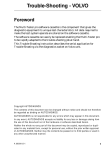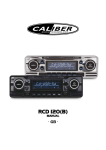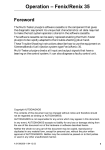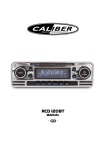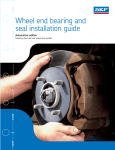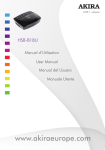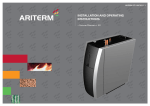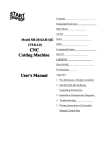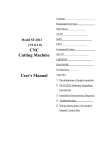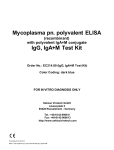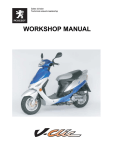Download Service Manual Section 2, D13-D21. 1991
Transcript
013 - Camshaft adjust (Carried out at 15,000 km and 90,000 km) Adjust the camshaft belt At an engine temperature of 40C (hand-hot engine) Rotate the crankshaft clockwise to TDC (22 mm socket). Remove the rubber plug in the timing gear cover. Undo the tensioning pulley nut 1 - 1.5 turns (17 mm socket). Tighten the nut. Refit the rubber plug. 014 - Camshaft, pump belt and idler pulley replace (Both camshaft and pump bell Special tools: 999... 5187, 5188, 5190, 5193, 5194, 5197, 5199, 5201, 5202 I mportant! The engine may only be turned over manually with the vibration damper. When the timing belt has been removed, neither the crankshaft nor the camshaft may be rotated, otherwise the valves may strike the piston and cause damage. Disconnect the earth lead from the battery and the splash-guard under the engine. Drain the coolant Remove the expansion tank cover. Remove the alternator Undo the servo pump with its bracket and let it hang l oosely. Automatic: Disconnect the oil cooling pipes from the radiator Remove: - radiator fan and pulley - radiator (D24 TIC: let the intercooler remain in position) - drive belts - valve cover - timing belt covers front and rear Remove: - alternator belt - fan shroud - radiator fan with spacer and pulley Remove: - left hose from the intercooler - A/C belt if fitted - inlet manifold extension with EGR pipe - crankcase ventilation hose from valve cover Remove: - valve cover - upper (front) timing gear cover - fuel pump belt cover Set cyl. no. 1 at TDC injection Turn the crankshaft with the vibration damper's centre bolt 27 mm socket or tool 999 5188). The two cams for cyl. 1 should point offset upwards, parallel with the plane. The flywheel 0-marking should be opposite the marking on the flywheel cover. Remove the vibration damper's centre bolt Use counterhold 999 5187, socket 999 5188 and drawbar handle to under the bolt. I t may be necessary to turn the engine a little to get the counterhold to fit securely against the fan bearing. Check that cyl.1 is at TDC for injection The flywheel 0-mark should be opposite the mark on the flywheel cover. Adjust if necessary, use counterhold 999 5187 to turn the crankshaft. Remove the vibration damper and lower timing gear cover Remove the four hexagonal screws, 6 mm. Withdraw the vibration damper. Remove the lower timing gear cover. Note! The vibration damper and crankshaft gear may sometimes stick together. Knock them apart if necessary. Remove the camshaft belt Undo the coolant pump's attachment screws and loosen the belt. Remove the belt. Remove the idler pulley The idler pulley should always be replaced when replacing the drive belt (timing gear belt) Remove the centre bolt. Pull out the idler pulley. Use pulley 999 5202. Tap the new idler pulley into place. Ensure that it is straight. Fit the centre bolt. Remove camshaft belt Undo the tension pulley nut and rotate the pulley as far from the belt as possible, then lock the pulley in this position. Remove camshaft belt. Check tension pulley: Rotate the pulley and listen for abnormal sounds from the bearing. Check that the pulley's surface facing the belt is clean and smooth. When changing the tension pulley: Check carefully that the spring is correctly positioned. Tension it with the hexagon spanner and fix the pulley with the nut. Check the idler pulley Rotate the idler pulley and listen for noise from the bearing. Check that the idler's surface against the belt i s clean and smooth. When changing the idler pulley: Remove the centre bolt and pull out the idler pulley. Use pulley 999 5202. Tap the new idler pulley into place, ensuring that it is positioned correctly. Fit the centre bolt, torque 25 Nm. Remove the fuel pump belt and rear camshaft gear Undo the pump bracket's attachment screws until the belt is slackened. Tighten one screw so that the pump remains in the upper position. Remove the fuel pump belt. Remove the camshaft gear. Use counterhold 999 5199 and socket 999 5201. Note! Take care to ensure that the camshaft is not rotated. Remove the front camshaft pulley Use counterhold 999 5199. Tap the pulley so that it comes away from the camshaft cone. Lock the camshaft in the 0 position Lift up the valve cover gasket. I nsert gauge 999 5190 into the groove at the rear of the camshaft. Place a feeler gauge, 0.2 mm, under the i nstrument's left side. The feeler gauge is used to compensate for tolerances i n the timing gear. Replace the 0-ring on the coolant pump Remove the coolant pump. Remove the splash guard and coolant pump's attachment screws. Pull the guard away and remove the pump. Make sure the guard does not crack. Remove the 0-ring Clean Clean the contact surface between the pump and the cylinder block. Wipe away all coolant from the cylinder block, pulley etc. Lubricate a new 0-ring with grease and fit it to the pump Do not use Permatex or any other sealing agent. Apply a thin layer of grease to the pump's contact surface. Pull out the splash guard and fit the pump in place. Loosely fit the pump's attachment screws. Fit the splash guard screws. Fit the camshaft belt and front camshaft pulley Ensure that the belt is properly located on the teeth of all the pulleys. Tighten the front camshaft pulley's centre screw by hand; it should be possible to rotate the shaft. D 24 TIC (EGR): Undo the tension pulley nut so that it moves freely. Fit the lower timing gear cover and vibration damper The vibration damper only fits in one position. On the crankshaft gear, there is a pin which is to fit into the vibration damper. Fit and tighten the hexagonal screws (6 mm) to 20 Nm (2.0 kpm). Fit the centre bolt Apply sealing agent (P/N nr 11 61 056-5) to the centre bolt's thread and the contact surface. Fit and tighten the centre bolt to 350 Nm (35 kpm). Use counterhold 999 5187, socket 999 5188 and torque wrench. The counterhold should fit against the fan bearing. Note! The 350 Nm value only applies when tool 999 5188 is used. In addition, the torque wrench must be in li ne with tool 999 5188. Check that cyl.1 is at TDC injection The flywheel 0-marking should be opposite the flywheel cover's marking. Adjust if necessary. Tension the camshaft belt Belt tension is adjusted at the coolant pump. Use tool 999 5197 to check belt tension. Thread the tool over the belt and set it at 12.5 units. Tension the belt until the mark on the piston is at the edge of the tool socket. Now apply firm hand pressure to the belt and check/adjust belt tension once again. Tighten the front camshaft pulley and then remove fixture 999 5190 Use counterhold 999 5199. Take care to ensure that neither the camshaft nor the pulley rotates. Tighten the centre bolt to 45 Nm (4.5 kpm). Remove gauge 999 5190 and the feeler gauge. Tighten the front camshaft pulley and then remove fixture 999 5190 Use counterhold 999 5199. Take care to ensure that neither the camshaft nor the pulley rotates. Tighten the centre bolt to 100 Nm (10 kpm). Remove gauge 999 5190 and the feeler gauge. Tension the camshaft belt Turn the crankshaft 2 revolutions clockwise, with loose tension pulley. Lock the tension pulley without allowing the crankshaft to stop, just before TDC is reached on the second revolution. Tighten the tension pulley nut to 15 Nm. Check belt tension with tool 999 5197 between the camshaft and idler pulley. Belt tension should be between 12-13 units; if necessary, adjust with the help of the tension pulley. Release the cold-start mechanism Undo screw 1. Press the lever forwards and turn the socket 90. Note! Do not touch screw 2. If this screw is loosened, the cold-start mechanism must be reset. Press the lever backwards against the stop. Basic installation of the injection pump Undo the pump's attachment screws (the inner screw i s a hexagonal 6 mm screw). Rotate the pump so that the markings on the pump and the pump bracket match. Tighten the attachment screws. Fit and reset the dial gauge Unscrew the plug from the pump's distributor unit. Fit retainer 999 5194 and dial gauge (measurement range min. 0-3 mm). Set the gauge at approx. 2 mm pre-tension. Lock the pump pulley in position in position for cyl.1 injection Rotate the pump pulley in the normal direction of rotation (clockwise viewed from the front) until the markings on the pump pulley and pump bracket match. Then rotate the pump pulley somewhat against the normal direction of rotation until the dial shows the l owest reading. Reset the gauge. Rotate the pump pulley back in the normal direction of rotation so that the markings on the pump pulley and pump bracket match. Lock the pump pulley in this position with mandrel 999 5193. (The mandrel is inserted through a hole in the pump pulley into one of the pump bracket holes.) Fit the rear camshaft pulley and pump belt Tighten the centre bolt by hand, the pulley should be able to be rotated at the camshaft. Tighten the pump belt Belt tension is adjusted with the pump brackets. Use tool 999 5197 to check belt tension. Thread the gauge over the belt and set it at 12.5 units. Tension the belt until the mark on the piston is at the edge of the gauge. Tighten the pump bracket's attachment screws. Apply firm hand pressure to the belt. Check/adjust the belt tension once again. Adjust the pump and tighten the rear camshaft pulley Position counterhold 999 5199, socket 999 5201 and a torque wrench. The torque wrench should be positioned perpendicular to 999 5201, otherwise the wrong tightening torque will result. Rotate the camshaft pulley slowly with counterhold 999 5199 in the normal direction of rotation, until the dial shows: D24 0.70 m m D 24 T 0.75 mm D 24 TIC 0.90 mm D 24 TIC (EGR) 0.95 mm Keep the camshaft pulley in this position. Tighten the centre bolt to 100 Nm (10 kpm). Take care that neither the camshaft nor the pulley change position. Remove mandrel 999 5193 from the pulley Check pump setting Turn the crankshaft until it is once again at cyl. 1 TDC i njection. If the engine is turned too much, it must first be returned approx. 114 revolution and then to the 0 mark, otherwise the adjustment will be incorrect. The dial should now show: D 24 0.65-0.73 mm D 24 T 0.72-0.80 m m D 24 TIC 0.87-0.95 mm D 24 TIC (EGR) 0.92-1.00 mm If the value is correct: Continue with "Remove dial gauge " If the value is incorrect: Adjust according to the following instructions. Adjustment of pump setting: Adjustment values: D24 D 24 T D 24 TIC D 24 TIC (EGR) 0.70mm 0.75 mm 0.90 mm 0.95 mm If the value is less than the adjustment value: Undo the pump's attachment screws and turn the pump i nwards to the adjustment value. Tighten the attachment screws and repeat the check of the pump setting. If the value is greater than the adjustment value: Undo the pump's attachment screws. Rotate the pump first outwards until the gauge shows approx. 0.60mm D24 0.65 m m D 24 T 0.80 mm D 24 TIC 0.85 mm D 24 TIC (EGR) Then rotate the pump inwards to the adjustment value. Tighten the attachment screws and check the pump adjustment once again. I mportant! Under no circumstances whatsoever should the pump be subjected to impacts or knocks since this affects the unit and results in faulty adjustment. Remove the dial gauge and retainer 999 5194. Refit the plug with a new seal. Torque 9 Nm (0.9 kpm). Connect the cold-start unit Press the lever forwards and turn the socket 90. Tighten screw 1. Note! Do not touch screw 2. If this screw is loosened, the cold-start unit will have to be readjusted. Fit the valve cover Use new gaskets if necessary. Fit the timing gear covers (front and rear) Use new gaskets if necessary. Fit: - all the drive belts - radiator fan with pulley - inlet manifold extension with EGR pipe - hoses to intercooler Fit: - the drive belts. Tension them until they can be pressed down 5-10 mm in the middle - radiator (TIC: complete with intercooler) - radiator fan with pulley - automatic: Fit the oil cooler pipes from the radiator - servo pump with bracket - alternator Prepare bleeding of the cooling system Remove the upper hose from the cold-start unit. Place a container under the hose. Hold the hose mouth roughly level with the top of the expansion tank. With this method, the cooling system is bled quickly and all air pockets are eliminated. Fill coolant Volume: with manual gearbox approx. 11 litres (11.7 litres with tropical radiator) with automatic gearbox approx. 10 litres (11.6 litres with tropical radiator) Use only Genuine Volvo coolant Cars with CU: Set the heater control to full heat. The function selector should not be on Max. Cars with ACC: Set the function selector to OFF. Start the engine and operate at raised idle speed for 5 minutes. Fill coolant during this period. Attach the hose to the cold-start unit. Top up the expansion tank all the way to the top (above max.) and fit the cap. D15 - System check 1x 0,5 -1 sec Attach selector cable to position 2 of the diagnosis socket. Read test function 1: Test function 1 is activated by pressing the button once. Code 1.1.1 i ndicates that there is no fault in the system. D16 - Exhaust gas recirculation (EGR) check the function Check the function Check that the valve opens and shuts when the engine speed rises. Note! The valve opens only when the engine is warm and engine speed exceeds idling speed. Checking the EGR valve - Ignition off - Connect the yellow hose to the EGR valve - Remove the yellow hose from the EGR converter - Start the engine - Pump up a vacuum (max. 30 kPa). If vacuum drops: - replace the EGR valve. If the engine runs unevenly at idling speed: - EGR valve OK. If the engine runs smoothly at idling speed: - Check that the EGR pipe is not blocked. - Clean the pipe if necessary - If the EGR pipe is OK, test with a new EGR valve. The engine should run unevenly when the vacuum pump shows negative pressure. Three alternatives are possible as below: 1 The engine runs unevenly when the vacuum pump shows negative pressure but the vacuum pump l oses vacuum: • Test with a new EGR valve. 2 The engine runs smoothly at idling speed when the vacuum pump shows negative pressure and the vacuum pump maintains vacuum: • Check that the EGR pipe is not blocked. Clean if necessary. If the EGR pipe is OK, test with a new EGR valve. 3 The engine runs unevenly at idling speed when the vacuum pump shows negative pressure and the vacuum pump maintains vacuum: • the EGR system is OK. D 1 7 - Exhaust gas recirculation (EGR) clean Clean Remove and clean both the valve and the pipe. Tap away any soot deposits; ensure that the valve and pipe are clean before refitting. Clean Remove: - the air hoses - EGR valve with temperature sensor - pipe connectors Tap away any soot deposits; ensure that the valve and pipe are clean before refitting. Refit the parts. D18 - Idling speed - CO-content Checking of idling speed and carbon monoxide content (CO) is generally not necessary for cars equipped with catalytic converters and Lambdasonds. Read this before checking/adjusting Exhaust evacuation. Connection of CO gauge Use an exhaust hose with open connector. If the exhaust evacuation is too strong, there is a risk of faulty measurement results. The CO gauge probe should penetrate about 480 mm i nto the exhaust pipe. If the probe does not penetrate sufficiently, there is a risk that the exhaust gas may be diluted with fresh air, thus producing a faulty measurement result. Note! On cars with a catalytic converter, the CO is measured ahead of the catalyst. Temperature Checking/adjustment of CO-content should be performed at room temperature (between +15°C and +25°C) and: • on carburettor engines: within 3 minutes after the cool ant thermostat has opened • on injection engines: at the earliest 5 minutes after the coolant thermostat has opened. • the electric fan, if fitted, should not have started. Prior to every reading or if the check/adjustment has not been able to be performed within 3 minutes (carburettor engines) • Raise engine speed briefly to approx. 25 r/s (1500 r/min) so that cold fuel enters the carburettor. • Observe the time factor. If CO-content is too high I f the car is driven a lot in city traffic (repeated starts, i dling), there may be a certain dilution of fuel with engine oil. Crankcase gases may thus influence the CO content and result in faulty adjustment. Check the CO-content with disconnected crankcase ventilation. I n normal cases, the CO-content drops somewhat when crankcase ventilation is disconnected. I f the CO-content drops considerably, this is an indication that engine oil is diluted with the fuel. The engi ne oil should be changed. The Pulsair system The Pulsair system, if fitted, should be disconnected and plugged for checking/adjustment of the CO-content. CO-content should not be checked/adjusted with the Pulsair system connected. F engines (with catalytic converter) On catalytic converter equipped engines, the CO-content and idling speed do not normally need to be checked. The new adaptive electronic control systems ensure that CO and idling values remain within the specified tolerances. Faulty values may be an indication of a fault in one of the systems. Measurement of the CO-content is performed ahead of the catalytic converter by removing a plug in the front exhaust pipe. On the B280F there i s a plug for each row of cylinders. The Lambdasond should always be disconnected when a CO meter is used. I dling speed, checking/adjustment Correct idling speed: cars without A/C: 14.2 r/s (850 r/m). cars with A/C: 15.0 r/s (900 r/m) (A/C shut off). Adjust the idling speed by turning the screw in the air cleaner cover. I mportant! Check the float chamber ventilation after idling speed has been adjusted. CO-content, checking/adjustment Checking: 0.5-2.5% Adjustment: 1.5 Note: The electric radiator fan should not start during adjustment of the CO-content. Fit a new seal after adjustment. Adjust idling speed after the CO-content has been adj usted. Check/adjust automatic engine speed compensator Check: Disconnect the hoses (A) and (B) from the electric three-way valve (1) and connect them together. Note! do not disconnect any other connections. Run the engine for about 10 seconds to stabilise the engine speed. Engine speed should now be 1375 -1425 r/m. I f any other engine speed is registered, adjust as foll ows. Adjustment: Remove the rubber plug (2). Adjust engine speed to 1400 r/m with adjustment screw (3) on the vacuum unit. Refit the rubber plug. Connect the hoses to their respective connectors on the three-way valve. Pre-set idling speed Hot engine. Correct idling speed: 15.0 r/s (900 r/min). Check/adjust CO-content Hot engine and idling speed. Use tool 5015. After each adjustment, the engine should be revved briefly before the meter is read. Note! First remove tool 5015 otherwise the meter lever may be damaged. - Anti-clockwise turn (left) reduces CO-content - Clockwise turn (right) increases CO-content Sealing, CO adjustment screw Legal requirement on certain markets. Remove the plug with an awl or similar tool. Press in a new plug after adjustment. Connect the hose to Pulsair Check/adjust idling speed Pulsair system if fitted, is disconnected. Connect the test socket to earth Adjust idling speed Use the idle screw to adjust idling speed to 11.7 r/s (700 r/min). Remove the earth cable from the test socket. Engine speed should now rise to 12.5 r/s (750 r/min). Check/adjust CO-content Nominal value: 0.5-2.0% For adjustment: Remove the seal: Engine switched off. Drill two holes in the plug. Drill diameter 2 mm. Withdraw the plug with circlip pliers. Start the engine. Adjustment value: 1.0% Rotate the adjustment screw - anti-clockwise to reduce the CO-content - clockwise to increase the CO-content Seal the adjustment screw Use a new plug. Tap it into place. Switch off air conditioning. Move the gear selector lever to N on cars with automatic gearbox. Check idling speed and adjust the basic setting (only B 18 EP) Set the selector cable to position 2. Start the engine. Activate test function 2 by pressing the button twice, 0.5-1 secs. each time. The LED will flash rapidly. I dling speed should now be as follows: B18EP 14.2 r/s (850 r/m) Adjust if necessary with the adjustment screw on the throttle valve housing. Reset test function 2 by pressing the button once, 0.5-1 secs. Remove the selector cable. I dling speed should now be as above. Checking/adjustment of CO-content (B 18 EP) The CO-content is measured in the exhaust tailpipe Should be adjusted with a hot engine and all current consumers switched off (incl. radiator fan); CO-content: - for adjustment: 1 .2 -1.4 - for checking, without EVAP: 1.0 -1.4 with EVAP: 0.8 - 3.0 Checking/adjustment of CO-content (B 18 UM, B20EP) Checking CO: Move the gear selector lever to N on cars with an automatic gearbox. Switch off the A/C and all current consumers apart from the daylight running lamps. Measure CO content in the exhaust tailpipe. The radiator fan should not be on during this test. CO-content at i nspection: B18U(M) 1.0-1.5% B20F(M) 0.5-1.5% Adjusting CO-content Switch off the engine and wait for at least 20 seconds. Remove the seal and connect tool 951 2019 to the connectors (between the engine and monitor) Start the engine. Press button S. Read the CO level. Adjust CO with the + and - buttons - CO too high: press the - button - CO too low: press the + button - Adjustment value 1.5 The CO level will continue to rise/fall after buttons + and - have been pressed. Press button S when the required level is reached. Switch off the engine and wait for at least 20 seconds. This gives the control unit time to enter the new value i nto system memory. Remove tool 951 2019 and seal the connectors once again. Switch off the air conditioner. Move the gear selector lever to N on cars with an automatic gearbox. Check/adjust the idling speed Set the idle control valve to the nominal value by earthing the cable which is beside the valve at the front of the engine. Switch off the air conditioner. Idling speed should now be 11.7 r/s (700 r/m); adjust if necessary via the screw on the throttle valve housing. Remove the earth connector from the test socket. The idling speed should now rise to 14.2 r/s (850 r/m). Checking/adjustment of the CO-content Important! The screw for adjustment of CO-content acts on a potentiometer and can be rotated max. 15 revs. Insert the CO-meter's probe. Remove the screw's seal. Adjust the CO-content via the adjustment screw. Turn anti-clockwise for lower CO-content. Turn clockwise for higher CO-content. Seal the screw. Checking: 0.4-0.8% Adjustment: 0.7% D19 - Doors, bonnet l ubricate hinges, bonnet lock Bonnet - lubricate - hinges - bonnet lock - safety catch Doors - lubricate - hinges (does not apply to the 400) - door stops - lock lugs - locks - bearings on rear doors (850) Tailgate - lubricate - lock (480) D20 - Service reminder resetting Diagnostic unit check function 4 Check function 4 in the control unit's diagnostic system i s used to reset information which is stored for the purpose of activating the service reminder lamp. This service function shall be reset at every service. Resetting the service reminder Applies only to VDO instruments. With odometer bel ow the needle. With Volvo Diagnostic Key See service manual section 3(35-38) Lighting, I nstrumentation and Other Electrical Equipment, 850 1992-, page 32. Manually I gnition on. Select position 7 at diagnostic socket A. Press 4 times, briefly but distinctly. You are now in check function 4. Press the first number (the key once) while the LED is still glowing. Do not press the second figure (press the key five ti mes) until the LED glows steadily again. Repeat the procedure for the third number (press the key once). Wait for a response from the control unit, whereby the LED flashes rapidly a couple of times. Resetting is complete and the service lamp is turned off. D21 - Power antenna clean Clean the antenna as follows: 1. Raise the antenna 2. Spray the antenna rod with CRC 5-56 or similar lubricant 3. Wipe the antenna dry 4. Spray the antenna rod once more 5. Raise and lower the antenna three times in succession 6. Wipe the antenna dry
























